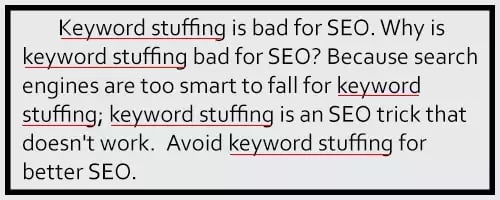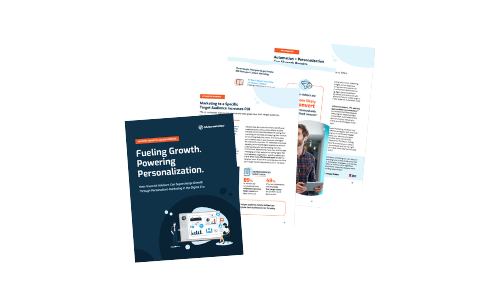Google is continuously updating its algorithms to provide users with the easiest search experience possible. Over the years, these updates have caused SEO practices that many marketers once found effective to become a disadvantage to your website's performance. These practices are now known as ‘black hat’ SEO practices and are against Google Webmaster Guidelines as they are purely aimed at raising search ranking, rather than providing quality information to an audience.
Here are a few ‘black hat’ SEO practices that you may not realize are hurting your website’s performance!
- Keyword Stuffing
- Non-Secure Sites (Missing SSL Certificates)
- Non-Responsive Sites (Not Mobile-friendly)
- Building Bad Links
- Paid Links
Keyword Stuffing
One SEO practice you’ve most likely heard of which is not as relevant today when it comes to increasing your search ranking is Keywords. Years ago, using the right keywords within your content could significantly increase your ranking, and it caused many marketers to turn to what’s called ‘keyword stuffing'.
What is Keyword Stuffing?
Keyword stuffing is quite literally the process of writing your content to include as many keywords as possible, to the point where it may hurt the readability of the article.

Google started to crack down on this SEO practice in 2003 and has continued to become more strict with it, penalizing websites which continue to do so. The reason for this is because content was being created with Google in mind instead of their audience and translated into low quality posts ranking at the top of search queries.
When it comes to search today, Google’s top priority is relevancy, and opening a blog that is barely legible because of keyword stuffing, translates into a horrible user experience for Google.
To avoid keyword stuffing, a best practice is to use a variety of language and synonyms. Google made a shift from keyword search to topic-focused SEO in 2013. Which means if your blogs are written with your audience in mind, then you’re following best practice and have nothing to worry about.
Non-Secure Websites
Another change to Google search algorithms that will affect your website’s performance is if your website is a non-secured site. Meaning your website is missing an SSL Certificate.
An SSL Certificate stands for Secure Sockets Layer, a feature that adds an extra level of security to your website. This security layer protects yours and your prospect's personal information from hackers, has an effect on lead generation and because of Google's update in August of 2014, it greatly affects your website’s performance and SEO.
Especially working in the financial services industry, if a prospect is seriously considering your services, being greeted with a “caution website not secure” is not the most reassuring message to receive.
Does your website have an SSL Certificate?
All of our websites built on Force platform automatically have an SSL Certificate built-in, however, if you’re website is built on our Legacy Platform, consider taking the time to speak with our website specialist to purchase one for your website.
How to identify if your website is secure
1. Bring up your website on Google search browser, and take a look at the search bar.
2. If your website URL has HTTP:// before it, your website is not secure.
3. If your website URL follows HTTPS://, you can breathe, the added S stands for Secure, which means your website has an SSL Certificate.
Here is how your URL will look with and without an SSL Certificate:
→ http://yoursite.com vs. https://yoursite.com
To learn more, read our blog on SSL Security and how it’s a necessary element to your website.
Non-Responsive Websites
Having a non-responsive website is an SEO element that has changed drastically over the years.
What is a non-responsive website?
A responsive website design ‘responds’ according to a device’s screen size (large or small), as well as its orientation (landscape or portrait). It’s fluid and dynamic, meaning it looks different across all mobile devices and content adjusts automatically. As a result, web visitors can find and use your website, no matter what device they're on (think smartphone, iPad, or laptop computer).
All of our websites are fully responsive, to ensure you look good no matter the device. Many people don’t realize that having a fully responsive website is no longer an option when it comes to SEO or even user experience. In 2019, it’s now an expectation of Google and your prospects.
Google updated its algorithm to prioritize mobile-friendly websites in search in April of 2015, and rightly so;
61% of mobile searchers are more likely to contact a local business if they have a mobile-friendly site (Junto, 2019)
Google drives 96% of mobile search traffic. (Jody Nimetz Co., 2018)
To learn more, read our blog on the importance of having a fully responsive website.
Building Bad Links
Just like keywords, what matters to Google when it comes to building links is quality over quantity. Building links with other websites (regardless if they were reputable or not) used to create authority with Google and helped raise your ranking.
Unfortunately, marketers began to build links for the sake of ranking higher on Google and not for the added value to their audience.
Google started to crack down on this practice in February of 2005 and has come a long way since then. Today, three links to quality websites will build better SEO than thirty links to irrelevant and non-reputable sites.
It’s recommended to focus on producing great content, as your website’s links may start to grow organically. Once your business builds authority, others will look to you as a thought leader. You may even already turn to other financial businesses in this way, or have even shared an article you found useful on your website or social media.
A great way to build good links to your website is by sharing your content on your social media accounts to create more opportunity for more people to read and share.
If you’re looking for more clarity on what bad links are versus good links, check out our last SEO webinar replay, where we discuss what kind of external links are beneficial to your website.
Paid Links
Low-quality links are not the only links you need to worry about; Google strictly prohibits the purchase of links and will penalize both parties involved within the exchange.
What is a paid link? Here is Google's definition:
Buying or selling links that pass PageRank. This includes exchanging money for links, or posts that contain links; exchanging goods or services for links; or sending someone a “free” product in exchange for them writing about it and including a link.
- Google (2019)
We are constantly reminding our clients that content is the driving force of your website and it seems that Google agrees:
The best way to get other sites to create high-quality, relevant links to yours is to create unique, relevant content that can naturally gain popularity in the Internet community. Creating good content pays off: Links are usually editorial votes given by choice, and the more useful content you have, the greater the chances someone else will find that content valuable to their readers and link to it.
- Google (2019)
Conclusion
To avoid being penalized by Google for using these ‘Black Hat’ SEO practices, keep in mind Google’s main objective when creating your content. Which is to provide users with the information they're looking for in their search queries (not articles stuffed with keywords, warning popups, incorrect formatting and bad links).
Therefore, create content with your target audience in mind and focus on providing value around topics they're interested in. Keeping your website content fresh and sharing it on social media are awesome SEO practices that Google favors, thanks to its update in Nov 2011. Having a secured and responsive website are also key SEO elements that provide a smooth user experience.
Learn more about SEO and what you can do today to optimize your site! Or learn more about Google’s Webmaster Guidelines here.
No time? Chat with one of our Website Specialists about our SEO Add-On packages! Or view our packages in more detail here.







